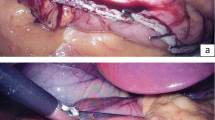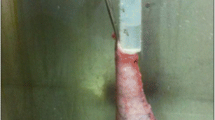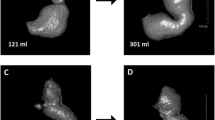Abstract
Background
Aiming to clarify the mechanism of weight loss after the restrictive bariatric procedure of sleeve gastrectomy (LSG), the volumes and pressures of the stomach, of the removed part, and of the remaining sleeve were measured in 20 morbidly obese patients.
Methods
The technique used consisted of occlusion of the pylorus with a laparoscopic clamp and of the gastroesophageal junction with a special orogastric tube connected to a manometer. Instillation of methylene-blue-colored saline via the tube was continued until the intraluminal pressure increased sharply, or the inflated stomach reached 2,000 cc. After recording of measurements, LSG was performed.
Results
Mean volume of the entire stomach was 1,553 cc (600–2,000 cc) and that of the sleeve 129 cc (90–220 cc), i.e., 10% (4–17%) and that of the removed stomach was 795 cc (400–1,500 cc). The mean basal intragastric pressure of the whole stomach after insufflations of the abdominal cavity with CO2 to 15 mmHg was 19 mmHg (11–26 mmHg); after occlusion and filling with saline it was 34 mmHg (21–45 mmHg). In the sleeved stomach, mean basal pressure was similar 18 mmHg (6–28 mmHg); when filled with saline, pressure rose to 43 mmHg (32–58 mmHg). The removed stomach had a mean pressure of 26 mmHg (12–47 mmHg). There were no postoperative complications and no mortality.
Conclusions
The notably higher pressure in the sleeve, reflecting its markedly lesser distensibility compared to that of the whole stomach and of the removed fundus, indicates that this may be an important element in the mechanism of weight loss.



Similar content being viewed by others
References
Mognol P, Chosidow C, Marmuse JP. Laparoscopic sleeve gastrectomy as an initial bariatric operation for high-risk patients: initial results in 10 patients. Obes Surg. 2005;15:1030–3.
Cottam D, Qureshi FG, Mattar G, et al. Laparoscopic sleeve gastrectomy as an initial weight-loss procedure for high-risk patients with morbid obesity. Surg Endosc. 2006;20:859–63.
Roa PA, Kaidar-Person O, Pinto D, et al. Laparoscopic sleeve gastrectomy as treatment for morbid obesity: technique and short-term outcome. Obes Surg. 2006;16:1323–6.
Givon-Madhala O, Spector R, Wasserberg N, et al. Technical aspects of laparoscopic sleeve gastrectomy in 25 morbidly obese patients. Obes Surg. 2007;17:722–7.
Han SM, Kim WW, Oh JH. Results of laparoscopic sleeve gastrectomy (LSG) at 1 year in morbidly obese Korean patients. Obes Surg. 2005;15:1469–75.
Weiner RA, Weiner S, Pomhoff I, et al. Laparoscopic sleeve gastrectomy—influence of sleeve size and resected gastric volume. Obes Surg. 2007;17:1297–305.
Mayer EA. The physiology of gastric storage and emptying. In: Johnson LR, editor. Physiology of the gastrointestinal tract. 3rd ed. New York, USA: Raven Press; 1994. p. 929–76.
Takahashi T, Owyang C. Characterization of vagal pathways mediating gastric accommodation reflex in rats. J Physiol. 1997;504:479–88.
Piessevaux H, Coulie B, Caenepeel P, et al. Role of impaired gastric accommodation to a meal in functional dyspepsia. Gastroenterology. 1998;115:1346–52.
Braghetto I, Korn O, Valladares H, et al. Laparoscopic sleeve gastrectomy: surgical technique, indications and clinical results. Obes Surg. 2007;17:1442–50.
Langer FB, Reza Hoda MA, Bohdjalian A, et al. Sleeve gastrectomy and gastric banding: effects on plasma ghrelin levels. Obes Surg. 2005;15:1024–9.
Kotidis EV, Koliakos G, Baltzopoulos VG, et al. Serum ghrelin, leptin and adiponectin levels before and after weight loss: comparison of three methods of treatment—a prospective study. Obes Surg. 2006;16:1425–32.
Karamanakos SN, Vagenas K, Kalfarentzos F, et al. Weight loss, appetite suppression, and changes in fasting and postprandial ghrelin and peptide-YY levels after Roux-en-Y gastric bypass and sleeve gastrectomy. Ann Surg. 2008;247:401–7.
Acknowledgment
The authors thank Nahum Beglaibter M.D for fruitful discussion.
Author information
Authors and Affiliations
Corresponding author
Rights and permissions
About this article
Cite this article
Yehoshua, R.T., Eidelman, L.A., Stein, M. et al. Laparoscopic Sleeve Gastrectomy—Volume and Pressure Assessment. OBES SURG 18, 1083–1088 (2008). https://doi.org/10.1007/s11695-008-9576-x
Received:
Accepted:
Published:
Issue Date:
DOI: https://doi.org/10.1007/s11695-008-9576-x




